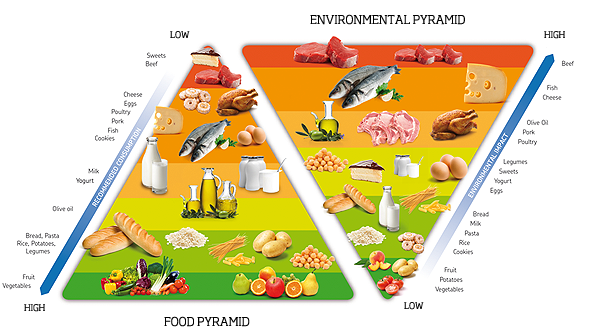For years, we’ve been looking at the food pyramid, and now Myplate, as a guideline for healthy eating. Fruits, vegetables and grains form the foundation, a reminder that these foods should make up a major portion of a healthy diet. As you go up the pyramid, it’s smart to have smaller portions of the food at the top, such as sweets and red meat. Keep in mind that a balance diet can include all foods as long as we practice moderation, and the pyramid and myplate remind us that moderation is important.
Learn more about the Double Pyramid and healthy, sustainable eating for your family at Nutrition & Children: Sustainable Models for the Future Generations – a webinar on Tuesday, October 11, 2011 at 11am ET/10am CT.
Recently, interest has been growing for sustainable eating. Think about the “locavore” movement – the growing number of people who pay close attention to where their food is from and try to eat locally. It’s a way to factor in the environmental impact of what you eat. If your food doesn’t have to be trucked hundreds of miles to reach you, it’s more environmentally friendly.
The Double Pyramid
In 2010, the Barilla Center for Food & Nutrition (BCFN) introduced a new way to look at healthy eating and its environmental impact: the Double Pyramid.

When you look at the Double Pyramid, you can quickly see which foods help you maintain a healthy weight, and the environmental impact of those foods. The foods at the top of the Environmental Pyramid have the highest impact on the environment.
What does Environmental Impact mean?
BCFN looked at several factors, including:
- Cultivation
- Processing
- Packaging
- Transport
- Cooking
It’s important to note that some foods with a larger environmental impact, like fish and olive oil, are valuable in a healthy diet. If you don’t live near the ocean or in a warm climate where olives grow, then these foods have to be shipped to you. There’s an environmental impact, but you can make careful choices to balance the health benefits with the costs.
Sweets fall in the middle of the Environmental Pyramid – but remember, that’s not a signal to have all the cookies you want! It’s important to consider where foods fall on both the Food and Environmental pyramids, then make your own smart choices.
Why is a sustainable diet important?
Ultimately, it’s about our children. In recent years, childhood obesity has become a major health problem in the US and other developed countries. This has been happening as families consume more and more highly processed food.
- A sustainable diet relies on fruits, vegetables and grains. If parents served more sustainable foods, like locally grown fruits and vegetables that are high in fiber and nutrients, in place of some processed foods, children could see big health benefits – like a return to a healthy weight.
- Sustainable foods are often less expensive, a welcome boost to families on a budget.
- And over the long-term, sustainable food helps the environment – and preserves a healthy future for our children.
For more information, visit Barilla Center for Food & Nutrition.
Note: This blog was sponsored by Barilla Center for Food & Nutrition (BCFN).

